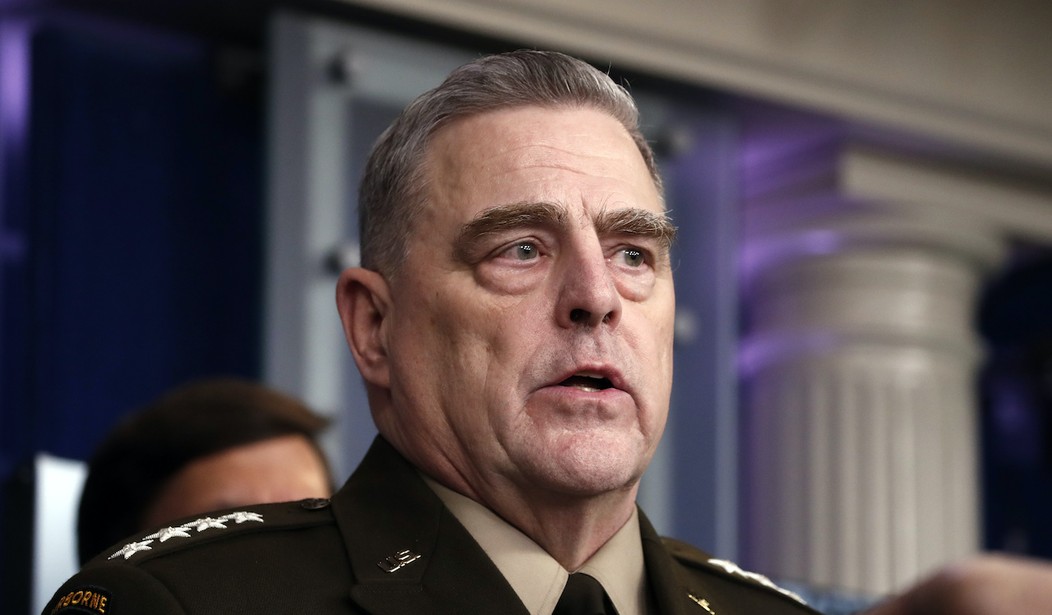Defense Secretary Lloyd Austin and Gen. Mark Milley, chairman of the Joint Chiefs of Staff, delivered their first briefing on Afghanistan since Kabul fell on Sunday. The two both delivered statements indicating that the situation in Afghanistan is “personal” to them because they served on the ground in Afghanistan during the 20-year war, as Deputy Secretary of State Wendy Sherman said during her briefing shortly before theirs.
Austin was stumped by a reporter’s question outlining the options facing the U.S. forces deployed to Afghanistan over the weekend.
Gen. Milley twice scolded Americans that now is not the time to criticize the decisions made or their consequences, saying there will be time for “AAR” — “after-action reports” — later.
Milley is at best a witness to one of the greatest failures in American military history, if not one of its principal architects.
Another reporter asked why the military command chose to abandon Bagram Air Base in the month prior to the fall. Austin demurred as if he did not understand or didn’t want to answer the question, and Milley took up answering.
Milley said that based on the number of forces needed to secure both Bagram Air Base and the embassy in the heart of Kabul, the in-country command made the decision to “collapse Bagram” and move forces to concentrate on securing the embassy and that decision was briefed up the chain all the way to the White House. Securing both would have required more forces than the 2,500 that were in country at the time.
The gambit to secure the embassy obviously failed, as the embassy collapsed and its personnel, including the ambassador, had to flee to Hamid Karzai International Airport, which the military refers to as HKIA. Milley’s answer indicated that Biden’s decisions left the military unable to safely carry out the operation he tasked it with.
Related: Not a Joke: Biden Admin’s Response to Taliban Violence Is a ‘Strongly Worded’ Letter
The reporter pointed out an obvious issue with this decision, namely, that Bagram had two operational runways while HKIA only has one. Thus, the second runway could have been used to double the evacuation throughput.
It also could have been used to provide military combat air support during the evacuation. The reporter did not bring this up, and neither did Gen. Milley, but it’s an obvious advantage the massive base could have provided. The second runway at Bagram would have given commanders on the ground flexibility that they do not have at HKIA. In fact, HKIA is vulnerable to one well-placed artillery shell that could damage the single runway enough to shut down the aerial evacuation. Then what?
U.S. forces could also have established and maintained a hard armored perimeter with close air support from combat aircraft prior to evacuating anyone at Bagram. Instead, the command decided to abandon Bagram and consolidate at HKIA. Among other consequences, abandoning Bagram left the Afghan military far less capable of resisting the Taliban’s advance on Kabul. The swift fall is leading to finger-pointing between the military and the intelligence community. Milley denied that intel provided any scenario under which the Taliban could take all of Afghanistan in just 11 days.
Using Bagram Air Base would have posed logistical issues to be sure. It’s more than an hour’s drive outside of Kabul, so moving personnel from Kabul to there could have created exposed convoys. But Bagram would have been easier to secure and more difficult for the Taliban to surround. The vast airbase could have been used to house many thousands of American and allied evacuees. Its remoteness could have been an advantage. Clearly, trying to evacuate thousands from within an airport that is surrounded by the enemy is far from ideal.
To stress the point again, the second runway at Bagram could have given commanders capabilities that they do not have at HKIA. as a result, the U.S. government still cannot assure any Americans or allied people safe passage.
New warning from U.S. Embassy Kabul: The United States government "cannot ensure safe passage" to the airport in Kabul for evacuation.
— Lucas Tomlinson (@LucasFoxNews) August 18, 2021
Bagram could have enabled a fighting retreat. Perhaps the swift drawdown left commanders with too few troops even to establish a defensible perimeter at Bagram Air Base.
The United States is now, according to one reporter’s pointed question, depending on the Taliban not to attack and kill Americans trying to get to HKIA or attack HKIA itself. Austin had no serious rebuttal.









Join the conversation as a VIP Member